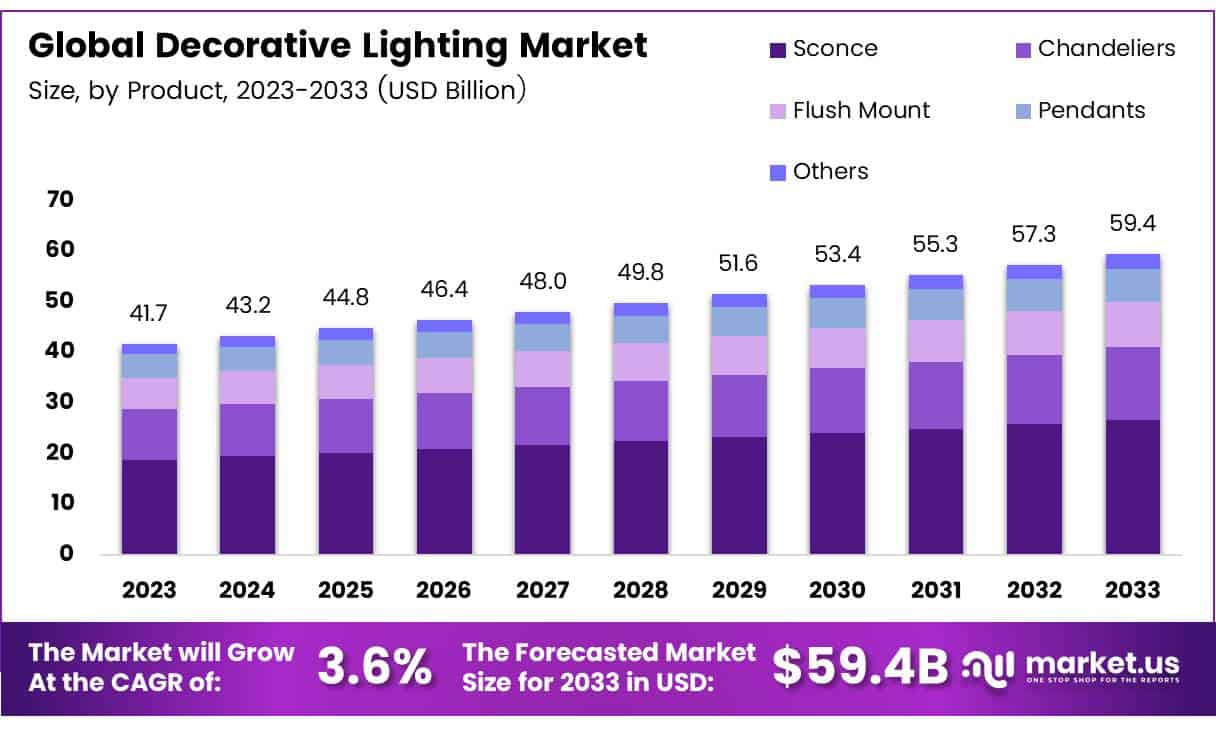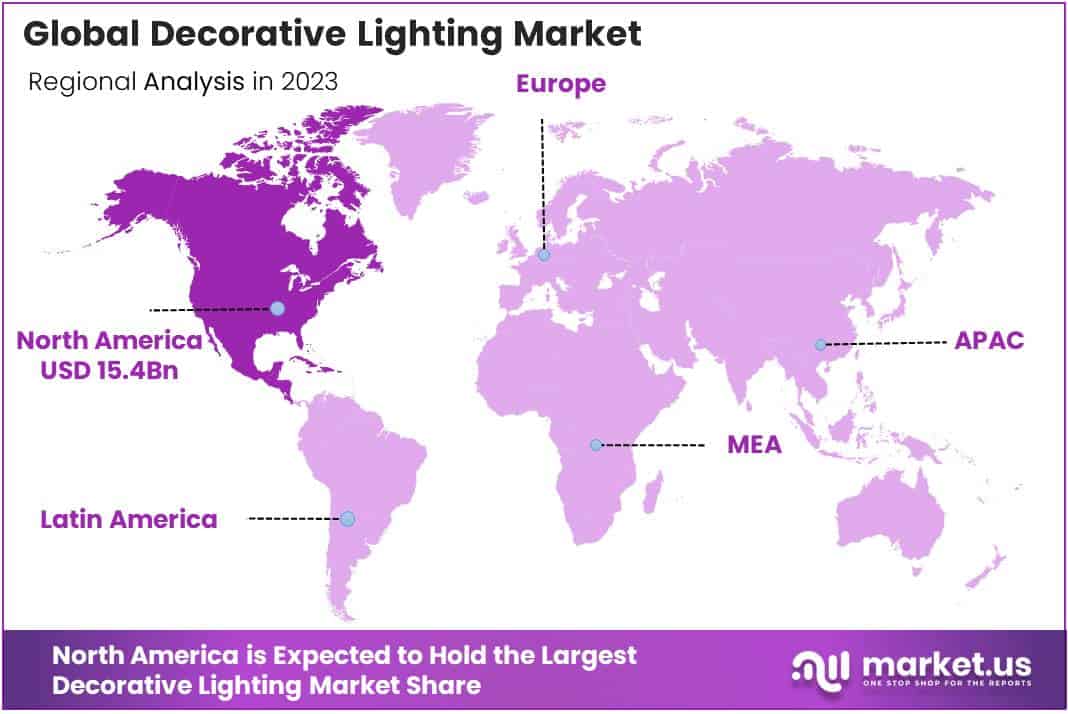Table of Contents
Introduction
The Global Decorative Lighting Market is projected to reach approximately USD 59.4 billion by 2033, rising from a valuation of USD 41.7 billion in 2023. This growth is anticipated to occur at a compound annual growth rate (CAGR) of 3.6% during the forecast period from 2024 to 2033.
Decorative lighting refers to lighting fixtures and solutions that serve both aesthetic and functional purposes, enhancing interior and exterior spaces through design elements, mood-setting illumination, and visual appeal. These lighting products, which include chandeliers, pendant lights, wall sconces, table lamps, and LED-based decorative strips, are primarily used in residential, commercial, and hospitality sectors to create ambiance and reinforce architectural styles.
The decorative lighting market encompasses the global production, distribution, and sale of these aesthetically oriented lighting solutions. This market is experiencing robust growth due to several underlying factors. Increasing consumer spending on home décor and renovation activities, particularly in urban areas, is a major driver, fueled by rising disposable incomes and evolving lifestyle preferences.
Additionally, the rapid expansion of the hospitality industry and the commercial real estate sector has significantly boosted the demand for premium and customized lighting fixtures to enhance customer experience and brand identity. Technological advancements, especially the integration of energy-efficient LED technologies and smart lighting systems, are also contributing to market expansion by offering sustainability, remote control, and design flexibility.
Moreover, the rise of e-commerce platforms has widened consumer access to a variety of decorative lighting products, thereby propelling market penetration in emerging economies. The growing trend of themed lighting, festivals, and seasonal décor further creates favorable conditions for market demand. Opportunities remain high in developing regions where urbanization and infrastructural investments are accelerating. Additionally, product innovation, particularly in eco-friendly materials and IoT-enabled lighting, presents long-term growth prospects as consumers and businesses alike prioritize design, efficiency, and sustainability.

Key Takeaways
- The global decorative lighting market is projected to expand from USD 41.7 billion in 2023 to USD 59.4 billion by 2033, registering a steady CAGR of 3.6% during the forecast period.
- Sconces dominate the product category, capturing a 34.6% market share. This reflects their strong alignment with evolving consumer preferences and contemporary interior design trends.
- LED lighting leads the light source segment, primarily due to its superior energy efficiency, extended lifespan, and increasing adoption across both residential and commercial sectors.
- The commercial application segment holds a prominent position in the market, supported by growing investments in commercial infrastructure development and a heightened focus on visual appeal and ambiance.
- North America commands a dominant 37.1% share of the global market, valued at USD 15.4 billion in 2023. This is attributed to high disposable income levels, widespread consumer awareness, and a well-established retail and hospitality ecosystem.
Report Scope
| Report Features | Description |
|---|---|
| Market Value (2023) | USD 41.7 Billion |
| Forecast Revenue (2033) | USD 59.4 Billion |
| CAGR (2024-2033) | 3.6% |
| Segments Covered | By Product (Sconce, Chandeliers, Flush Mount, Pendants, Others), By Light Source (LED, Incandescent, Fluorescent, Others), By Application (Commercial, Household) |
| Competitive Landscape | ACUITY BRANDS, INC., Lowe’s, GE Lighting, LSI Industries, Hubbell, Generation Brands, Juno, Philips Lighting (Signify Holding), Home Depot, OSRAM GmbH |
Emerging Trends
- Organic and Sustainable Designs: There is a growing preference for lighting fixtures crafted from natural materials such as bamboo, rattan, and recycled glass. These designs not only enhance aesthetics but also align with eco-friendly values.
- Integration of Smart Features: The adoption of smart lighting systems is on the rise, allowing users to control lighting through mobile applications or voice commands, thereby enhancing convenience and energy efficiency.
- Wellness-Oriented Lighting: Lighting solutions that mimic natural light cycles are gaining popularity, as they contribute to improved sleep patterns and overall well-being.
- Statement Lighting Pieces: Consumers are increasingly investing in bold, decorative lighting fixtures that serve as focal points within interior spaces, reflecting personal style and enhancing room ambiance.
- Layered Lighting Concepts: The use of layered lighting, combining ambient, task, and accent lighting, is becoming prevalent, offering flexibility and depth to interior lighting schemes.
Top Use Cases
- Residential Spaces: Homeowners are utilizing decorative lighting to enhance interior aesthetics, create mood settings, and highlight architectural features.
- Hospitality Industry: Hotels and restaurants employ decorative lighting to establish ambiance, improve guest experiences, and differentiate their brand identity.
- Retail Environments: Retailers use decorative lighting to attract customers, highlight merchandise, and create inviting shopping atmospheres.
- Event and Exhibition Spaces: Decorative lighting is essential in events and exhibitions for creating thematic environments and enhancing visual appeal.
- Outdoor and Landscape Lighting: There is an increasing use of decorative lighting in outdoor settings to improve safety, highlight landscaping, and extend the usability of outdoor spaces into the evening.
Major Challenges
- High Initial Costs: The upfront investment required for high-quality decorative lighting solutions can be a barrier for some consumers and businesses.
- Environmental Concerns: Manufacturers face pressure to develop environmentally friendly products, necessitating changes in materials and production processes.
- Rapid Technological Changes: Keeping pace with technological advancements requires continuous investment in research and development.
- Market Competition: The decorative lighting market is highly competitive, with numerous players striving for market share, leading to pricing pressures.
- Supply Chain Disruptions: Global supply chain issues can affect the availability of materials and components necessary for manufacturing decorative lighting products.
Top Opportunities
- Smart Lighting Integration: The incorporation of Internet of Things (IoT) technologies presents opportunities for creating interconnected lighting systems that offer enhanced functionality and user control.
- Sustainable Product Development: Developing lighting solutions with recyclable materials and energy-efficient technologies can meet the growing consumer demand for sustainable products.
- Expansion in Emerging Markets: Increasing urbanization and rising disposable incomes in emerging economies offer significant growth potential for the decorative lighting market.
- Customization and Personalization: Offering customizable lighting options can cater to individual consumer preferences, enhancing customer satisfaction and brand loyalty.
- Collaborations with Designers: Partnering with interior designers and architects can lead to innovative lighting solutions that meet specific design requirements and trends.
Key Player Analysis
In 2024, the global decorative lighting market is characterized by robust competition among key players, each leveraging unique strengths to meet evolving consumer demands. Acuity Brands, Inc. maintains its leadership through innovative, energy-efficient lighting solutions and a strong distribution network, appealing to both residential and commercial sectors . Retail giants Lowe’s and Home Depot capitalize on the DIY trend by offering extensive decorative lighting ranges, catering to diverse consumer preferences and budgets. GE Lighting, under Savant Systems, emphasizes smart home integration, enhancing user experiences with connected lighting solutions.
LSI Industries focuses on customized lighting designs, serving niche markets with tailored solutions. Hubbell Incorporated upholds its market presence by delivering durable, high-quality lighting products suitable for various applications. Generation Brands distinguishes itself through unique design offerings, appealing to consumers seeking distinctive aesthetics. Juno Lighting specializes in track and recessed lighting, providing precision-focused products for specific market segments.
Philips Lighting (Signify Holding) leads in sustainable innovation, offering smart LED solutions that align with global energy efficiency trends . OSRAM GmbH continues to drive technological advancements, reinforcing its position in both residential and commercial lighting sectors. Collectively, these companies shape the decorative lighting landscape by integrating design excellence with technological innovation.
Top Key Players in the Market
- ACUITY BRANDS, INC.
- Lowe’s
- GE Lighting
- LSI Industries
- Hubbell
- Generation Brands
- Juno
- Philips Lighting (Signify Holding)
- Home Depot
- OSRAM GmbH
Regional Analysis
North America Leads the Decorative Lighting Market with Largest Market Share of 37.1%
North America accounted for the largest share of the global decorative lighting market in 2024, capturing approximately 37.1% of the overall revenue. The regional market was valued at USD 15.4 million, indicating robust consumer demand, advanced distribution channels, and high spending on home décor and aesthetic lighting enhancements.
The region’s dominance can be primarily attributed to the rising trend of residential renovations, premium interior aesthetics, and the growing consumer inclination towards smart and energy-efficient lighting systems. Moreover, strong adoption across commercial spaces, hospitality, and luxury retail outlets has further boosted the regional consumption of decorative lighting solutions.
The United States remains the key contributor to the North American decorative lighting market, supported by rising disposable incomes and a matured retail infrastructure that facilitates easy access to a wide variety of decorative lighting products. However, the imposition of U.S. tariffs on imported lighting components, particularly from Asian economies such as China, has had a marginal impact on the pricing dynamics and import volume.
These tariffs have compelled manufacturers and retailers to reassess their sourcing strategies and supply chains, resulting in a shift towards regional manufacturing and increased adoption of domestic products. Despite these challenges, the market remains resilient due to consumer preference for high-quality and branded lighting solutions that offer both functionality and visual appeal. As a result, North America is expected to maintain its leading position in the global market landscape, supported by sustained demand and ongoing innovation in lighting design and smart connectivity.

Recent Developments
- In 2023, Acuity Brands, Inc. made a key move by signing a definitive agreement to acquire KE2 Therm Solutions, Inc., a company known for smart refrigeration control technologies. The goal was to boost energy efficiency and reduce service costs in cooling systems. The integration was planned under Distech Controls, part of Acuity’s Intelligent Spaces Group, aiming to expand its smart building solutions.
- In 2024, Kingswood Capital Management completed the acquisition of Kichler Lighting, LLC from Masco Corporation. Following the acquisition, Kingswood merged Kichler with Progress Lighting, forming a stronger platform in the North American residential lighting market. This merger brought together two well-known brands with deeper distribution and a broader product line.
- In 2024, Q-Tran made its first acquisition by bringing Excelsior Lighting into its fold. Excelsior, based in California, is known for its exterior lighting products. This strategic step helped Q-Tran expand its presence in the landscape lighting sector and diversify its product offerings to serve a wider range of customer needs.
- In 2024, Panzeri took an important step to strengthen its U.S. market reach by acquiring Luxxbox, a California-based lighting brand. Luxxbox is known for its modern, sound-absorbing lighting designs. With this acquisition, Panzeri aimed to combine Italian design expertise with innovation in acoustic lighting, helping the company grow in both product variety and international presence.
Conclusion
The global decorative lighting market is poised for sustained growth, driven by increasing consumer focus on home aesthetics, the expansion of the hospitality sector, and advancements in smart lighting technologies. The integration of energy-efficient LED solutions and IoT-enabled systems is enhancing user convenience and promoting sustainability. Emerging trends such as the use of organic materials, customizable designs, and wellness-oriented lighting are reshaping consumer preferences. Additionally, the proliferation of e-commerce platforms is broadening market access, particularly in developing regions. Despite challenges like high initial costs and supply chain disruptions, the market is expected to thrive, supported by ongoing innovation and a growing emphasis on personalized, eco-friendly lighting solutions
Discuss Your Needs With Our Analyst
Please share your requirements with more details so our analyst can check if they can solve your problem(s)





